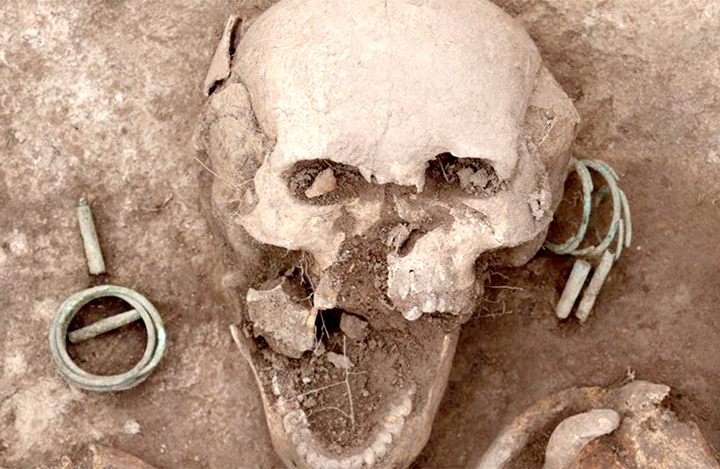Hezký šperky 👍😃
Rare 3,000-year-old grave of woman with unusually heavy bronze jewellery discovered in Siberia
Categories: Nálezy nejenom s detektorem kovů ve východní Evropě
Archaeologists in the Republic of Khakassia in southern Siberia have discovered a richly furnished female tomb with a number of massive, heavy bronze jewels made specifically for funerary purposes. The grave lay near a stone cairn, dating from the 8th to 10th centuries BC.
The remains of a woman were found in a relatively shallow tomb, lying at the western side of the stone cairn, whose central grave had been looted centuries earlier. At only 76 cm deep, the grave is one of the few to have escaped damage during the construction of the highway and railway that bisect the burial site. However, much of the extensive necropolis has been irreparably damaged by workers in the past.
The woman was laid in a supine position with her head to the southeast. The shoulder blade and foreleg of a large horned mammal were placed at the left foot as funerary offerings. With them lay the broken blade of a bronze knife. A large round vessel with a decorative rim was placed near the head.
Above her wrist the woman wore a large bronze bracelet with a checkered design, and the four fingers of her left hand were adorned with large bronze rings - each with two bronze "pearls". On either side of the skull were three bronze "temple" rings; beside them were two triangular plaques. At the right elbow, archaeologists found eight small bronze buttons and a large round bronze plaque 9 centimeters in diameter.
The skeletal remains are in poor condition but still largely in their original anatomical distribution. The woman has been identified as a member of the Karasuk culture, who were renowned for their high-quality craftsmanship of bronze objects cast in wax.
Archaeologists believe this is a custom-made burial set, not jewelry that the woman would have worn during her lifetime. In fact, they bear no signs of wear, not even the small scratches that occur even with careful handling. Moreover, the rather considerable weight of the jewellery made its normal use virtually impossible and would certainly not have contributed in any way to the comfort of the owner.
"We usually see small scratches or other signs of use. When we get back to the lab, we'll have to do more research, but after the first study, all the artifacts looked brand new.," said Dr Oleg Mitko, head of the Sagaisky archaeological team from the Novosibirsk Institute of Archaeology and Ethnography. He added: "The size of the jewels also provides considerable support for this thesis; they were not suitable for wearing in real life. Quite probably (in life) she wore something similar, but definitely smaller. She was obviously quite wealthy."
From the small buttons that once adorned the long-decomposed burial garment, to the massive bracelet, they were allall the jewellery was made in the same artistic style that is so typical of the Minas Basin in the Late Bronze Age. They were probably cast to order from a single foundry. All her clothing, outfits and jewellery formed a perfectly matched set, which accompanied the deceased even after her death in a style that corresponded to her former wealth and high status.
Video









Roman Nemec
Sources: siberiantimes.com, thehistoryblog.com
The article is included in categories:









